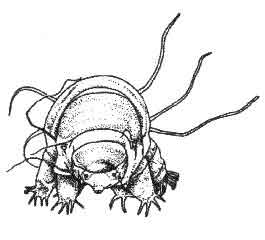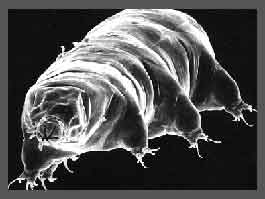Hello, Guest!
Zoological excursions
Bear animalcules (Tardigrada)
Antoni van Leeuwenhoek, a microscope inventor, was the first who observed these microscopic semitransparent animals in 1702. He collected dust from the water gutter on the roof of his house and, to his great surprise, found in this dust living organisms under microscope. In 1776, an Italian scientist Lazzaro Spallanzani repeated this experiment and named these animals as tardigrades (in Greek bear animalcules) for their unhurried movements.
|
|
At present, the ability of bear animalcules to fall into anabiosis state is well known, which surprised the first researchers of these animals. Under the effect of unfavourable external factors – drying, cooling, starvation, etc. they diminish in sizes, their extremities are retracted and the body shape is like a barrel. In this state, bear animalcules can withstand the cooling to up -190ºC for several months, -271ºC for many hours, and for a shorter period of time high temperature +150ºC, complete absence of oxygen, and effect of different chemical factors and radiation. Under favourable conditions (for example moistening), they revive quite fast.
|
|
|
Bear animalcules are tiny animals (0.2-1.2 mm) with a more or less elongated segmented body and 4 pairs of nonsegmented extremities with claws, the last pair directed backwards. They move very slowly – 2-3 mm a minute. Their position in the system of invertebrates is not clear enough – they occupy an intermediate position between nematodes and arthropods. Bear animalcules have a digestive, excretory and nervous systems, and a well-developed musculature. They are dioecious animals. However, they do not possess respiratory and vascular systems: they breathe through the skin or a cuticle. Liquid filling the whole body play the role of blood in which there are large cells containing nutrients.
Males of bear animalcules are smaller than females. They are met very rarely. Therefore, parthenogenesis sometimes occurs, i.e. female reproduction without fertilization. About 1-30 eggs mature in the female ovary during reproduction. Some species lay eggs into the water, others – into the fell which females shed. The development of bear animalcules is direct; a young bear animalcule grows from a mature egg differing from an adult one in smaller sizes.
At present, there are over 750 species of bear animals. They need water for their life and growth. Few species have been found in seas, a larger number are registered in freshwater bodies. The majority of species inhabits moss and lichen pillows not only on land but also on the stems of trees and rocks – in places which are periodically watered and dried. The number of bear animalcules in the moss may be very high – hundreds or even thousands of animals in 1 g of dried moss. Their favourite place of habitation is reflected in English names: “water bears” and “moss pigs”.
Bear animalcules feed on plants on which they live, on algae, and sometimes on tiny animals, e.g. rotifers. They are spread passively – by wind, water and different animals. They are widely distributed around the whole world. They are met not only in hot and temperate countries but far in the north (e.g. on Spitsbergen) and high in the mountains (4000 m).
In Lake Baikal, bear animalcules inhabit shallow waters on the sand or among aquatic vegetation. Only 6 species of these amazing animals are known in Lake Baikal, which were identified by an Italian scientist Ramazotti. It is most likely that the fauna of Baikal bear animalcules looks for its researchers and will appear to be much richer that it is expected to be nowadays.
Copyright © 2005-2010 ЦНИТ ИГУ, 

Дизайн web-студия ЦНИТ ИГУ






